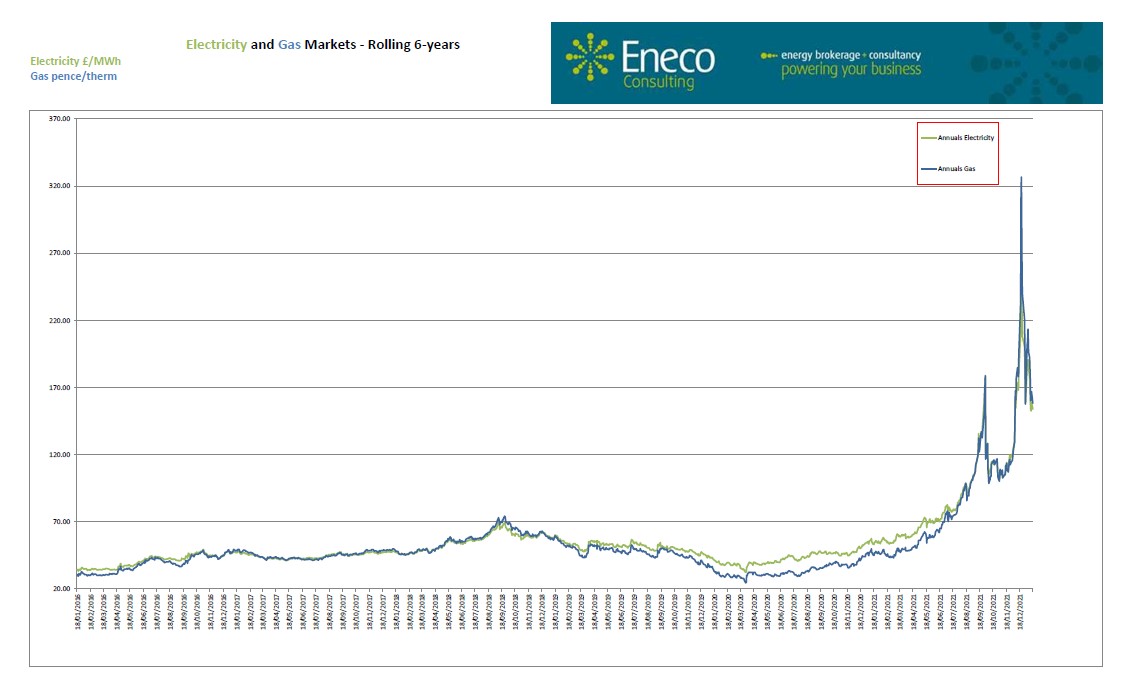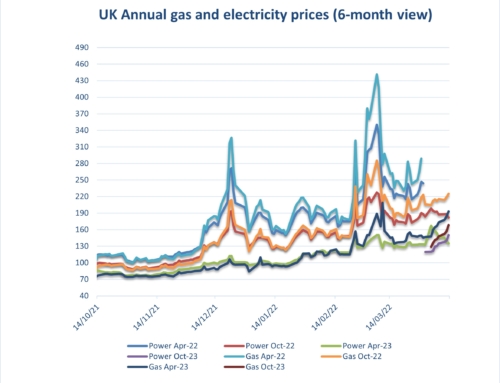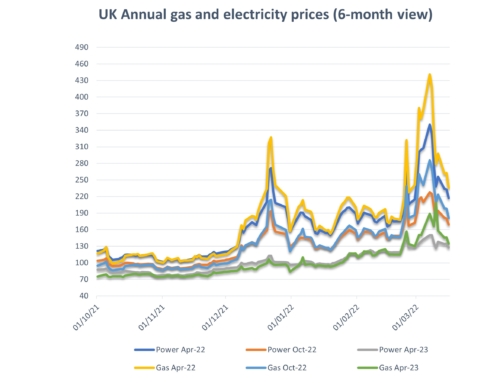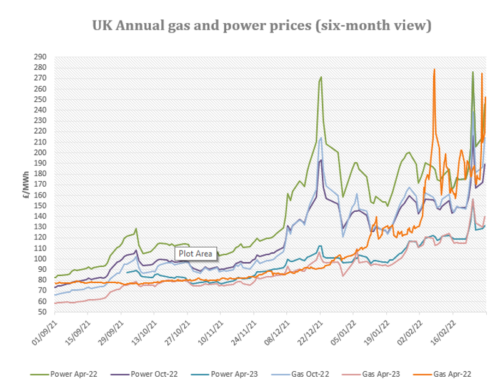Eneco market reports mid-January 2022
Energy costs:
The rebound in UK power and gas prices seen in the first week of January largely unwound in the second week, as supply fears abated and the sell-off resumed – until last Friday, when the markets bounced on news of further cuts to French nuclear power plant availability and Russia-US talks on Ukraine ended without resolution. News of diplomats being withdrawn from the Ukraine has already seen an increase in energy prices this week.
EDF have extended outages at five reactors – a couple of which by more than eight months – has had an impact on forward pricing, including Summer and Winter 22.
Milder, windier and sunnier weather forecasts, plus a continued delivery schedule from LNG into Europe have had some positive impact, although this was not reflected in day-ahead prices.
Outlook:
- Wind output is forecast to be on the low side between 20-27 January, although an increase is expected in the last few days of the month. G9iven current concerns over the gas market means that any thermal generation replacing missing renewable energies will be relatively high priced.
- From late March we should see IFA2 reach its full 2GW capacity resulting in an increase in UK import capacity, doubling the existing capability on the cable link to France.
Coal-fired units have also been brought onstream since January 9th to boost supply, accounting for up to 4% of national daily production. Prices for Day-ahead and the remaining days this week are now squarely back beneath £200/MWh, as renewables output has increased.
- The predicted downwards correction does seem to be coming to fruition.
Prices across UK gas periods have softened significantly since January 6th, the peak of the new year rebound, several dropping back to the lows seen in December – as supply confidence has improved despite continuing low Russian flows, inconclusive US-Russia talks on Ukraine, Norwegian outages and temperatures dropping below zero across the UK. A rise in LNG imports, falling forward Asian LNG prices, forecasts of milder weather, increased coal-burn by generators and Dutch pledges to ramp up production have all helped weigh on talk.
That being said, a move to remove diplomats from the Ukraine has seen an increase in prices this week.
Unplanned outages at several Norwegian fields and terminals have on occasion impacted short-term pricing, although North Sea flows have generally been strong despite these.
European gas storage volumes are now at 47% overall, compared to 62% at the same time last year.
North Sea oil prices, which still feed into price formulae on some long-term European supply contracts as well as Asian LNG contracts, meanwhile have been pushed to a seven-year high, of over $87/barrel, helped by drone attacks in the UAE by Iran-backed Houthi rebels stoking regional tensions, an improved demand outlook as Omicron fears have eased and US inventories dropping by more than expected.
Outlook:
- At normal weather conditions, and with low Russian imports, European storage levels will be at a record low resulting in increased refill requirements of around 20-25 BCM more than last year.
- Norwegian 2021 gas pipeline exports to European countries rose 5.6% last year, to 113.2 BCM – their third highest level ever. Similarly high exports are expected this year.
- “Expectations for increased US LNG supplies, the existence of healthy Asian storage, robust and flexible Norwegian gas deliveries and higher than expected production in the Netherlands,” will all continue to weigh on forward gas prices this year, according to Cedigaz, the gas industry information association.
Factors supporting Increases:
Gas storage – European storage volumes are 25% below where they were this time last year.
Carbon – EUA carbon emissions, meanwhile, are off EUR 8/TCO2 from their early January rebound high – at EUR 80/TCO2, while UKAs are off almost £5/TCO2 – at just over £72/TCO2.
Coal – Currently priced at $108/tonne and back beneath 200£/MWh as renewable output has increased.
French Nuclear Power – Ongoing maintenance at 5 nuclear power stations continues to impact.
Weather/Wind – Mild temperatures and low wind generation are expected this week, although this is expected to improve towards the end of the month.
Nord Stream 2 – Ongoing licencing concerns exist with Germany with no clear sign-off date in sight.
Russia/Ukraine Tensions – Ongoing tensions continue with diplomats being withdrawn from the Ukraine
Factors supporting decreases:
LNG –LNG deliveries have been consistent with a total of 31 cargoes expected to have been received by the end of January.
Oil markets – Oil remains consistent at around $86/barrel.
Supply outages – Further Norwegian outages contributed to this week’s market spike although they appear to be resolved for the moment.
Non-energy costs:
On the electricity side organisations will see further increases in pass through costs from both government and industry infrastructure providers from 2022 onwards due to pandemic-related demand destruction. Levies normally collected via unit rates have fallen short of expectations and have fed through to further increases in ROs, FiTs, EII and other transportation, distribution and renewable investment charges. In addition to this the Targeted Charging Review (TCR) is coming into effect from April 2022 and is being priced into renewal contracts now. Projections are available on our website via the links below.
What is the Targeted Charging Review (TCR) electricity –
TCR is a change to both Distribution Use of System (DUoS) and Transmission Network Use of System (TNUoS) charges you will find within a supply contract.
DUoS: changes in effect from 01/04/2022 (delayed from 2021)
- Paid to the associated distributor (DNO), the cost covers installation and maintenance of local distribution networks.
- At present, a DUoS charge is based on the volume of electricity consumed at site, which has passed through the distribution network.
TNUoS: changes in effect from 01/04/2023 (delayed from 2022)
- Paid to National Grid, the cost recovers the cost of installing and maintaining transmissions systems.
- At present, the charge is based on a meter’s share of demand on the network during 3 peak periods, known as Triads. These 3 Triad periods occur between 1st Nov to 28th Feb each year. It’s assessed during this time as demand on the grid is at its highest.
Why the change? A lot of businesses have Triad avoidance techniques in place. During November to February, the 3 largest consuming days will affect a TNUoS charge for a whole year, therefore it pays to be savvy in cutting down consumption on days which would otherwise have been large consuming. Ofgem want to eradicate an unfair grid, therefore both DUoS and TNUoS charges will be veering away from a consumption-based charge to a daily-based charge, determined by voltage type (where you connect to the network), measurement class (Half-Hourly/Non-Half-Hourly), and maximum agreed capacity.
It’s a complex change and difficult to assess the impact on individual meters as suppliers are allocating charges differently. although many are wrapping TCR into increased standing charges. However, to summarise, meters with high capacity but lower usage will be worst affected. For example, a sports stadium will have a high agreed capacity to account for large peaks on event/match days, yet for the most part will have a relatively small usage compared to this capacity. If you want to discuss this further, please call into the office to speak with Abby.
Is your organisation covered by the new Streamlined Energy and Carbon Reporting (SECR) scheme from the Environment Agency?
Designed to replace in part the Carbon Reduction Commitment (CRC) which ended in 2019 and to follow on from the energy savings recommendations generated by ESOS compliance. Note, SECR will cover a wider scope of organisations than CRC and ESOS do. SECR requires all large enterprises to disclose within their annual financial filing obligations to Companies House, their greenhouse gas emissions, energy usage (from gas, electricity and transportation as a minimum), energy efficiency actions and progress against at least one intensity ratio.
If your organisation qualifies, participation in this scheme is mandatory. Eneco Consulting are happy to provide assistance with your regulatory obligations. Full details are available on our website on the link below.
Are you eligible for an EII rebate?
Under current rules, if you qualify at an industry sector level and your business passes the 20% electricity intensity test you may qualify for exemption to CFD and RO charges. Please see the attached Government RO/CFD guidance document and update and give Abby a call on the main number to discuss this further.
Eneco market information Mid-January 2022
Rolling 6-Yeart Gas and electricity prices to Mid-January 2022
Rolling 6-Year Gas Pricing Trends
Rolling 6-Year Electricity Pricing Trends
A copy of our environmental charges and Climate Change Levy rates from 2012 to date: Industry and Environmental Pass Through Charges including CCL p/kWh Updated 31082021
A copy of RO/CFD guidance document: RO_CFD_Guidance_Revised_July_2018
SECR: SECR EA Guidelines
TCR Charges (Targeted Charging Review this will be revised in November 2021 when Ofgem releases its review): TCR Charges (Targeted Charging Review) TNUOS bandings and Current Ofgem Costs now for 2023 onwards




